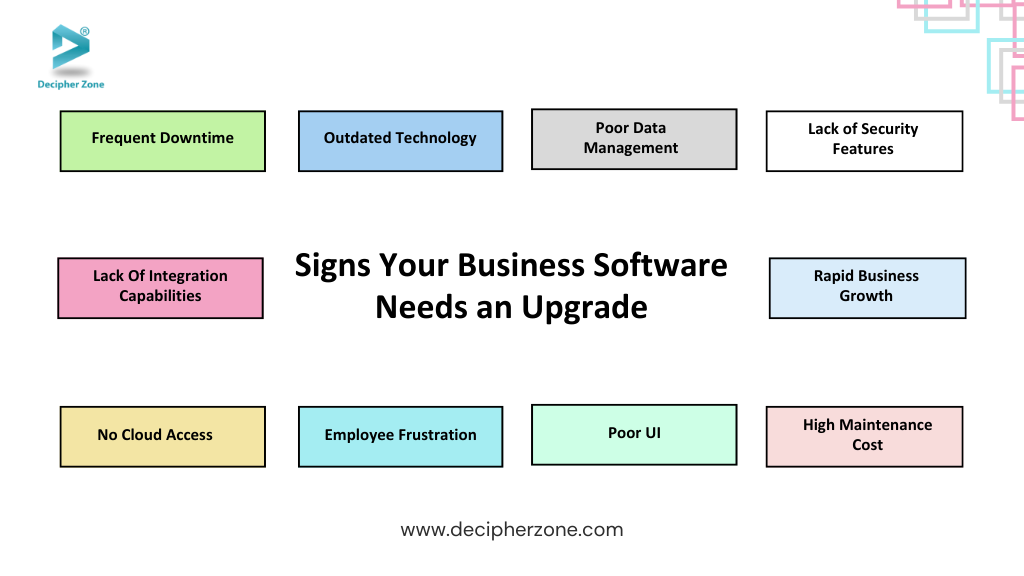Embracing new technologies and adapting to the constantly shifting demands of the market goes beyond mere appearances. It's a strategic move to enrich business operations through software upgrades, allowing businesses to improve customer satisfaction through personalized experiences and faster service responses. In this blog, we will discuss the telltale signs that indicate your software needs an upgrade.
Software systems act as the spine of business operations, performance, and the ability to stand out. However, staying ahead of the competition demands that these systems remain updated and adaptable to emerging technologies.
Admittedly, this can be a challenging endeavor. While software updates may seem like a hassle, neglecting them could expose your system to cyber threats.
So, how can you determine whether it's time to upgrade your software? In this blog, we’ll outline key indicators to help you make informed decisions about software upgrades.
What is a Software Upgrade?
A software upgrade refers to installing a newer version of a software application, which typically includes various enhancements compared to its predecessor. These upgrades may introduce new features, address bugs, apply security patches, enhance performance, improve user interface elements, ensure better compatibility with other systems, and update supporting documentation.
The purpose of these upgrades is to significantly enrich the overall user experience and make sure that the software remains relevant and effective in an ever-evolving technological environment.
Top 10 Signs Your Software Needs an Upgrade in 2025
With clearer insight into software upgrades, we can now take the next step and explore the indicators that can help you determine when it’s time to upgrade your legacy software.
1. Frequent Downtime
If your software system is facing frequent crashes or ongoing downtime, it’s crucial to consider an upgrade, as it likely no longer meets the needs of your users or your business. Frequent outages and crashes hinder user experience and disrupt productivity, potentially costing the company millions in lost efficiency.
2. Outdated Technology
An outdated tech stack that fails to align with current market demands can significantly impact business performance. A lack of modern features and capabilities may restrict your organization’s ability to adapt to innovative technologies, eventually hampering business growth and expansion.
3. Poor Data Management
Data is the cornerstone of success in the digital world. However, older software might struggle to process, organize, and store data. These limitations prevent businesses from getting valuable insights for decision-making and strategizing.
To survive in this competitive market, upgrading software becomes essential to thrive and make informed decisions as advanced software improves data management and empowers teams to leverage insights for better outcomes.
4. Lack of Security Features
If your system fails to meet the security and industry compliance measures, your business data faces substantial risk. As cyber threats escalate daily, outdated software becomes increasingly susceptible to attacks, which can lead to devastating financial losses for businesses—often reaching millions annually.
Therefore, it’s crucial to invest in software upgrades that incorporate advanced security features to protect data along with your market reputation.
5. No Cloud Access
Cloud computing is transforming the software industry by allowing businesses of all sizes to improve scalability, reliability, and execution while minimizing the need for an in-house IT team.
Without access to cloud computing, business owners risk missing out on valuable growth opportunities. By using cloud technology, you can wave goodbye to inconsistent software updates and enjoy a fast, up-to-date system that benefits both users and teams.

6. Employee Frustration
Employees' feedback on software performance can be a significant indication of checking its efficiency. If your team is expressing frustration with the existing software stating problems like slow performance, complexity, or limited functionalities, it can be a strong sign that the software needs to be upgraded.
7. Poor UI
An unintuitive or clunky user interface of the software can deter users from using the software efficiently, leading to unsatisfactory performance, inefficiencies, and errors.
If you are seeing such UI-related issues in your software it’s time to work with the UI team to upgrade the UI and make it easy to navigate with intuitive features, leading to better user experience and streamlined workflow.
8. High Maintenance Cost
As the system gets older, the cost related to its maintenance, patch fixes, and troubleshooting starts escalating. This increased expense is often due to the need for specialized technical support to keep the system functional.
If your organization also has to spend tons of resources and money in maintaining the legacy system running rather than innovating, consider an upgrade for good.
9. Lack Of Integration Capabilities
In an increasingly connected world, having the ability to integrate the software system with other applications is critical for smooth functioning. If your business software lacks integration capabilities with different platforms and essential tools, it can cause disrupted processes and data silos.
With software upgrades, you can get integration support to streamline workflow and improve collaboration with other systems.
10. Rapid Business Growth
For every expanding business, upgrading software is essential to meet the continuously changing market demands and complexity. As legacy systems are not sufficient to scale effectively, they hinder the ability of a business to expand its operation.
On the other hand, advanced solutions are designed with scalability at their core allowing businesses to adapt to rapid growth without compromising on performance.
Closing Thoughts
Recognizing when it is time to upgrade software can save your business from falling by maintaining its security, compatibility, productivity, and competitiveness. While you can always go the extra mile and recruit an in-house software development team to accomplish this task, outsourcing a software development company can be the best choice to achieve this goal.
Why? Well, the answer is simple, it is you can have access to the vast talent pool with experience in a myriad of technologies, all without the added costs of maintaining an in-house team.
We at Decipher Zone have a team of professionals who have years of experience up their sleeves working with numerous industries. All you have to do is, contact us and share your requirements, our team will provide you with a customized quote with the number of resources we can offer for your project, all while being mindful of your budget.

Questions You Might Have, Answered
-
What are the factors you need to consider when upgrading software?
Frequent Downtime, Outdated Technology, Slow Performance, Lack of Security Features, No Cloud Access, Employee Frustration, Poor UI, High Maintenance Cost, Lack Of Integration Capabilities, and Rapid Business Growth are some of the factors you can consider to determine if your software needs an upgrade.
-
Why upgrade the tech stack?
Upgrading the tech stack of the software is important to optimize its performance, security, productivity, and scalability. It also helps your business to adapt and thrive in the market while mitigating risks associated with technical debt and legacy software.
-
How often do you think a company should upgrade its systems?
A company should upgrade its software every 3-5 years as it helps maintain performance, technical compatibility, and security.

